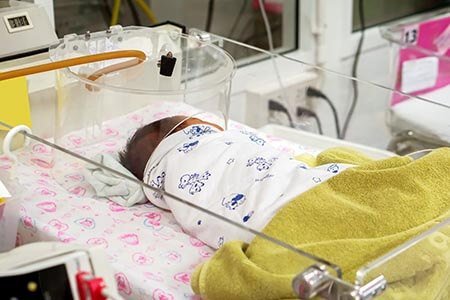Premature birth and premature babies
Risk factors, complications, treatments, intensive care, and supportive care
Understanding the Specific Needs of Premature Babies
What is premature birth?
The length of a normal pregnancy is between 37 and 42 weeks. A child born during this duration is termed as a normal term infant.
When the birth of baby takes place at least three weeks before the estimated date of delivery (before 37 weeks of pregnancy), it is considered as a premature birth. Such babies are known as “preemies” or premature babies.
Depending on the time of birth, premature births can be classified as:
- Late preterm: Babies born between 34 and 36 completed weeks of pregnancy.
- Moderately preterm: Babies born between 32 and 34 weeks of pregnancy.
- Very preterm: Babies born at less than 32 weeks of pregnancy.
- Extremely preterm: Babies born at or before 25 weeks of pregnancy.
In a majority of cases, the premature births occur in the late preterm stage.

What is Premature Birth?
How are premature babies different from normal term babies?
Premature babies can often face certain medical issues, more so if they are born very early.
Some commonly seen signs of prematurity are:
- Disproportionately large size of the head and a small body size
- Lack of fat stores, resulting in sharper features and low body temperature
- Fine hair (lanugo) on a major portion of the body
- Difficult breathing or respiratory distress
- Inadequate sucking reflexes, resulting in difficulty in feeding
What are the risk factors for premature birth?
Although there may not be any specific causes for premature birth, some common risk factors for premature delivery are:
- Structural defects of the cervix or placenta, uterus
- Emotional stress
- History of multiple abortions or miscarriages
- Conception through in vitro fertilization
- Infections of the genital tract or amniotic fluid
- Less than a six-month interval between two pregnancies
- Obesity
- Lifestyle habits like smoking, alcoholism or drug addiction
- Previous history of premature birth
- Trauma or physical injuries
- Twins, triplets or multiple pregnancies
- Underlying medical conditions like high blood pressure and diabetes
What are the possible complications of premature birth?
Although every premature baby doesn’t experience complications, a very early delivery may lead to health problems in short or long terms. Risk of complications increases with prematurity and less birth weight.
Some short-term complications of premature birth:
- Immature respiratory system, leading to breathing problems
- Developmental issues in the heart and associated problems
- Mild to severe bleeding within the brain
- Problems with body temperature control
- Immature digestive system resulting in mild-to-serious complications
- Blood-related complications like anemia and jaundice
- Problems of metabolism like decreased blood sugar levels
- Immature immune system resulting in a higher risk of infection
Some long-term complications of premature birth:
- Cerebral palsy (a disorder which hampers the movement, muscle tone or posture)
- Learning disabilities
- Problems of vision due to retinopathy
- Hearing loss
- Dental problems like delayed tooth eruption, discoloration, and misaligned teeth
- Behavioral and psychological problems
- Chronic health issues like recurrent infections and asthma

Complications of Premature Birth
What are the common tests advised for premature babies?
The neonatologists or pediatricians may order some common tests and monitoring for premature babies. Some of these include:
- Fluid input and output
- Blood tests
- Echocardiogram
- Ultrasound scan
- Eye exam
What is the supportive care suggested for a premature baby?
Preterm babies often need a prolonged stay in special nurseries of a hospital. In case of complications, they may also require to be placed in the neonatal intensive care unit (NICU) to monitor vital parameters. Additionally, some preterm babies may need:
- Blood transfusion
- Feeding tubes and intravenous tubes
- Medications to promote maturing and to stimulate the normal functioning of the lungs, heart, and circulation
- Surgery may be required in some cases to manage developmental defects in newborn babies

Intensive care for a premature baby
What factors should you consider while choosing a hospital for premature baby care?
A premature baby requires special medical care. Hence, choosing a well-equipped hospital to handle these needs is crucial, to ensure a protective environment and temporary home. Look for a hospital with an advanced NICU, 24 hours availability of trained staff and support services.
The NICU should be equipped with:
- Incubator
- Phototherapy, exposure to a special type of light, to manage neonatal jaundice
- Sensors to monitor vital parameters
- Ventilator support for artificial breathing
- 24 hours diagnostic support
- Neonatal care team comprising of the neonatologist and trained nursing staff, dietitian and therapists
When is your premature baby ready to go home?
Depending on the opinion of your pediatrician, your baby will be ready to go home when he or she:
- Is able to breathe without support
- Acquires a stable body temperature
- Can feed from breast or bottle
- Shows sign of weight gain
- Doesn’t show any signs of infection
Even at home, the premature babies require special care. Please consult your pediatrician regarding home care needs of a premature baby at discharge.
To know more about premature birth and babies, you can request a callback and our premature babies specialist will call you and answer all your queries.
References
- Mayo Clinic. Premature birth. Available at: https://www.mayoclinic.org/diseases-conditions/premature-birth/symptoms-causes/syc-20376730. Accessed on 7th January 2018.
- Centers for Disease Control and Prevention. Premature Birth. Available at: https://www.cdc.gov/features/prematurebirth/index.html/. Accessed on 7th January 2018.
- US National Library of Medicine. Premature Babies. Available at: https://medlineplus.gov/prematurebabies.html/. Accessed on 7th January 2018.
- NHS UK. Premature labour and birth. Available at: https://www.nhs.uk/conditions/pregnancy-and-baby/premature-early-labour/?/. Accessed on 7th January 2018.
Disclaimer:
“The content of this publication has been developed by a third party content providerwho are clinicians and/or medical writers and/or experts. The information contained herein is for educational purpose only and we request you to please consult a Registered Medical Practitioner or Doctor before deciding the appropriate diagnosis and treatment plan.”



 Appointment
Appointment Second Opinion
Second Opinion WhatsApp
WhatsApp Call
Call More
More





